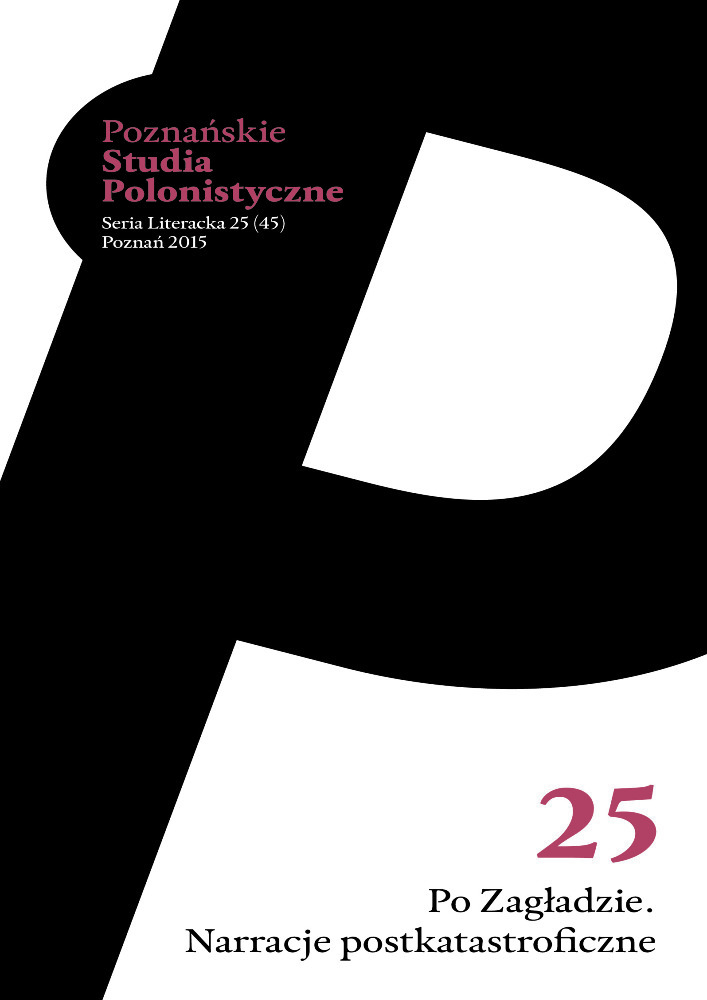Abstract
The article is an attempt to apply the theoretical and analytical tools derived from ecocriticism and the environmental studies, in the analyses of the literature of the Holocaust. The author proposes a thesis that a full recognition of the role of non-human factors (non-humans), such as nature, landscape, climate, plants and animals became only possible after the anthropocentric paradigm in the humanities have been overcome and a new, supra-species kind of “agency”—elaborated from the theory of Brunon Latour—became widespread. The principal part of the essay contains the analyses of the role of landscape, organic and inorganic nature in the autobiographical prose of Piotr Rawicz, Henryk Grynberg and Wilhelm Dichter. In all of the studied writings nature assumes the function of an ethical subject and additionally the role of anti-historical narration.References
Adorno Theodor W., Horkheimer Max (1994), Dialektyka Oświecenia, przeł. Magdalena Łukasiewicz, posłowie Marek Siemek, Wydawnictwo IFiS PAN, Warszawa.
Baudillard Jean (1992), Tranzparenz des Bön. Ein Essay über extreme Phänomene, przeł. Martin Otz, Merve Verlag, Berlin.
Bauman Zygmunt (1992), Nowoczesność i Zagłada, Masada, Warszawa.
Broswimmer Franz (2002), Ecocide. A Short History of the Mass Extinction of Spieces, Pluto Press, London.
Chakrabarty Dipesh (2014), Klimat historii. Cztery tezy, przeł. Magda Szcześniak, „Teksty Drugie”, nr 5, s. 168-199.
Cobel-Tokarska Marta (2012), Bezludna wyspa, nora, grób. Wojenne kryjówki Żydów w okupowanej Polsce, IPN, Warszawa.
Czapliński Przemysław (2012), Literatura i życie. Perspektywy biopoetyki, w: Teoria, literatura, życie. Praktykowanie teorii w humanistyce współczesnej, red. Anna Legeżyńska, Ryszard Nycz, Wydawnictwo IBL PAN, Warszawa.
Dichter Wilhelm (2000), Koń Pana Boga, Znak, Kraków.
Didi-Huberman Georges (2008), Obrazy mimo wszystko, przeł. Mai Kubiak Ho-Chi, Universitas, Kraków.
Domańska Ewa (2013), Humanistyka ekologiczna, „Teksty Drugie”, Warszawa, s. 13-31.
Fiut Aleksander (1998), Natura devorans, natura devorata, w: Moment wieczny. Poezja Czesława Miłosza, Wydawnictwo Literackie, Kraków, s. 67-75.
Friedlaender Saul (1992), Introduction, w: Probing the Limits of Representation. Nazism and the „Final Solution”, red. Saul Friedlaender, Harvard University Press, Cambridge, s. 5-8.
Goślicki Jan (2003), Przedmowa, w: Piotr Rawicz, Krew nieba, przeł. Andrzej Socha, Wydawnictwo Krakowskie, Warszawa, s. 7-17.
Grynberg Henryk (1989), Żydowska wojna, Czytelnik, Warszawa.
Hilberg Raul (2007), Sprawcy, ofiary, świadkowie. Zagłada Żydów 1939-1945, przeł. Jerzy Giebułtowski, Centrum Badań nad Zagładą Żydów IFiS PAN, Cyklady, Warszawa.
Kwieciński Bartosz (2012), Obrazy i klisze. Między biegunami wizualnej pamięci Zagłady, Universitas, Kraków.
La Capra Dominick (2009), „Traumatropisms”: From Trauma via Witnessing to the Sublime?, w: tegoż, History and Its Limits. Human, Animal, Violence, Cornell University Press, Ithaca–London.
La Capra Dominick (2010), Powrót do pytania o to, co ludzkie i zwierzęce, przeł. Katarzyna Bojarska, w: Teoria wiedzy o przeszłości na tle współczesnej humanistyki, red. Ewa Domańska, Wydawnictwo Poznańskie, Poznań.
Latour Bruno (2000), Zirkulierende Referenz. Bodenstichprobe aus dem Urwald Amazonas, w: Die Hoffnung Pandora. Untersuchungen zur Wirklichkeit der Wissenschaft, przeł. Georg Rossler, Suhrkamp Verlag, Frankfurt am Main.
Latour Bruno (2011), Nigdy nie byliśmy nowocześni. Studium z antropologii symetrycznej, przeł. Maciej Gdula, Oficyna Naukowa, Warszawa.
Levene Mark (2013), „Climate Blues”: or How Awerness of the Human End might Re-instill Ethical Purpose to the Writing of History, „Environmental Humanities”, t. 2, s. 147-167.
Levinas Emmanuel (2000), Bez imienia, w: Imiona własne, przeł. Janusz Margański, KR, Warszawa, s. 133-140.
Mazel David (2000), American Literary Environmentalism, The University of Georgia Press, Athens–London.
Morton Timothy (2012), The Oedipal Logic of Ecological Awarness, w: „Environmental Humanities”, nr 1, s. 7-21.
Rabinbach Anson (2003), „The Abyss that opened up before us”: Thinking about Auschwitz and Modernity, w: Catastrophe and Meaning. The Holocaust and the Twentieth Century, red. Eric Santner, Mosze Poistone, The University of Chicago Press, Chicago.
Rawicz Piotr (2003), Krew nieba, przeł. Andrzej Socha, Wydawnictwo Krakowskie, Kraków.
Rosenfeld Alvin H. (2003), Wyobraźnia ‘in extremis’, w: Podwójna śmierć. Rozważania o literaturze Holocaustu, przeł. Barbara Krawcowicz, Cyklady, Warszawa, s. 105-126.
Smith Mick (2013), Ecological Community, the Sense of the World, and Sensless Extinction, „Environmental Humanities”, t. 2, s. 21-41.
Ubertowska Aleksandra (2007), Świadectwo, trauma, głos. Literackie reprezentacje Holokaustu, Universitas, Kraków.
Ubertowska Aleksandra (2013), Natura u kresu (ekocyd). Podmiotowość po katastrofie, „Teksty Drugie”, nr 1-2, s. 33-44.
Wines James (2008), Zielona architektura, przeł. Michał Frankowski, Taschen, Koeln.
Wolfe Cary (2013), Animal studies, dyscyplinarność i post(humanizm), przeł. Karolina Krasucka, „Teksty Drugie”, nr 1-2, s. 125-153.
Ziębinska-Witek Anna (2005), Holocaust. Problemy przedstawiania, Wydawnictwo UMCS, Lublin.
License
Authors
Authors of texts accepted for publication in „Poznańskie Studia Polonistyczne. Seria Literacka” are required to complete, sign and return to the editor's office the Agreement for granting a royalty-free license to works with a commitment to grant a CC sub-license.
Under the agreement, the authors of texts published in „Poznańskie Studia Polonistyczne. Seria Literacka” grant the Adam Mickiewicz University in Poznań a non-exclusive, royalty-free license and authorize the use of Attribution-NoDerivatives 4.0 International (CC BY-ND 4.0)Creative Commons sub-license.
The authors retain the right to continue the free disposal of the work.
Users
Interested Internet users are entitled to use works published in „Poznańskie Studia Polonistyczne. Seria Literacka” since 2016, for non-commercial purposes only, under the following conditions:
- attribution - obligation to provide, together with the distributed work, information about the authorship, title, source (link to the original work, DOI) and the license itself.
- no derivatives - the work must be preserved in its original form, without the author's consent it is not possible to distribute the modified work, such as translations, publications, etc.
Copyrights are reserved for all texts published before 2016.
Miscellaneous
Adam Mickiewicz University in Poznań retains the right to magazines as a whole (layout, graphic form, title, cover design, logo etc.).
